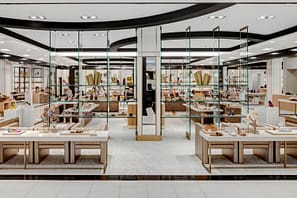Seeing Red:
Color and Light
By Gary Bouthillette | Senior Director of Lighting Design
Light and color are critical to the human experience. Without light we would not see color (or much else for that matter). Although color is not an inherent property of matter, an object appears to have color because of the way it interacts with light as perceived by the eye and interpreted by the brain.
The perception of color involves physics and the physiology and psychology of the viewer. For that reason, no two people will see color in exactly the same way.
Our response to light and color begins earlier than most people realize—in utero. At 34 weeks we can track the movement of light and see one color—red, the color of our surroundings. Nature is the agent here because the color-sensitive cells in the eye receptive to red are the first to develop. Almost from day one, the impact of light and color are an integral part of our experience.
Allowing for cultural and regional differences, the emotional impact of color is generally considered universal due to our shared biology, although more research is needed. Associations connecting color, light, and emotions are an ongoing area of inquiry.

Yext New York City | Photography by Garrett Rowland
Predictable Effects
For illumination and viewer impact some applications of lighting and its effects are well understood. For example, light distribution angles such as up light or intense side light glare can make people feel scared or uncomfortable. These lighting angles feel unnatural and are often used in horror movies because of their emotional impact. Overall, lighting and color contribute to our understanding of our environment and affect our mood, eliciting overt and subliminal effects influenced by personal experience.
At the start of every project to take full advantage of color and lighting, we ask our clients what they want users or visitors to feel/experience when entering the proposed space and its various settings. The answers will differ, driving unique solutions tailored for each engagement. However, to that end, some general lighting scenarios will create predictable impacts:

R.F. Moeller Jeweler St. Paul, MN | Photography by Corey Gaffer
Ready for Business

Cool overhead lighting suggests serious intent, signaling a readiness for work and productivity.
Relaxed

Lower light levels and perimeter lighting at or below eye level project a residential vibe that puts people at ease.
Primed for High Expectations

Multiple layers of light generate an elevated, sophisticated feel and sense of anticipation.
Confident

High levels of light encourage greater clarity, arouse emotions, likes, dislikes, and opinions, inspiring decision-making and participation.
Awed/Wowed

Color-changing and animated lighting deliver highly complex state-of-the-art lighting effects for a powerful impact.
Energized

Blue wavelengths of light revitalize and are associated with positive feelings. They evoke the beneficial circadian rhythm system of physical, mental, and behavioral change that occurs over 24 hours.
The positioning and layering of lighting also affects our perception of space. Bright illumination with lighting on walls and ceiling creates a sense of spaciousness. Low light with minimal perimeter lighting implies a more intimate, private space. Lower overhead illumination with some of the space lit in warm tones suggests relaxation.
In surprising ways, the brightness of a lit space can affect our actions and focus. For instance, at restaurants with higher light levels, we are more apt to opt for healthier food choices and enjoy lighter meals. At restaurants with lower light levels, less healthy options are often selected as we relax, inhibitions recede, and dining proceeds at a more leisurely pace.
And, as noted in an earlier post, a compelling design in terms of materials, layout, and the sculpting of space can be significantly negated without the right lighting. Lighting can diminish color and texture or bring it to its full strength and richness.

InterContinental Rome Ambasciatori Palace | Photography by Mattia Aquila
Wellbeing
The effect of natural light on well-being and health is widely documented and an important factor in all IA designs. Natural glare-free light boosts creativity, mood, and cognitive performance. Unbalanced lighting at the workplace can negatively affect mood and even contribute to poor sleep due to impacts on hormone levels.
In addition, the use of light therapy is inspiring intriguing speculation today and an array of results – especially the use of light boxes for depression, red light for a range of skin disturbances, some very serious, and green light therapy to manage pain.

United Airlines Chicago | Photography by Garrett Rowland
Without light we cannot see and with light comes color even if it is attenuated as in the case of those with color blindness. Color and light reveal the true nature of a space, influencing our experience in a variety of ways. The art and science of lighting is a critical component of every IA design geared to creating a tailored experience that advances community, interaction, innovation, well-being, and productivity.
This is the second in a series of three posts on lighting. Stay tuned for the third post that will focus on IA’s lighting labs with a video walk-through of the lab at IA’s Los Angeles studio.
Gary Bouthillette, AIA, NCARB, LC
Principal, Senior Director of Lighting
Contact Gary: g.bouthillette@interiorarchitects.com

